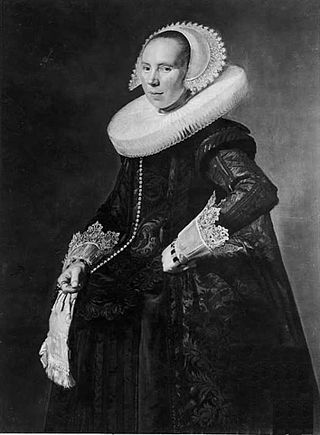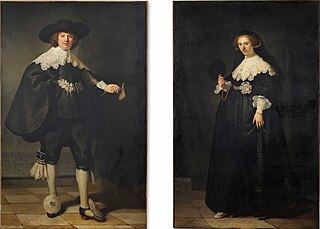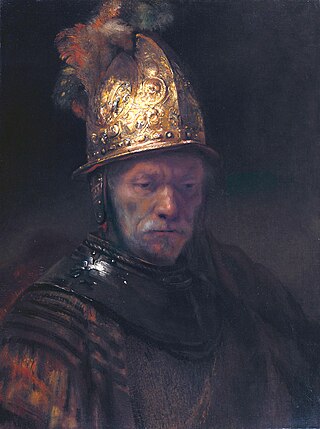Description
This painting was documented by Hofstede de Groot in 1915, who wrote:
712. JAN SIX (1618-1700). [2] Sm. 329; Bode 6; Dut. 228; Wb. 348; B.-HdG. 371. More than half-length; life size. He stands, seen in full face, turned slightly to the left with his head bent over a little on the right shoulder, and looks straight out of the picture. He is about to go out; he has put his large black felt hat on his long fair reddish hair, and with the right hand, which holds one glove, he draws the other glove on to his left hand. He wears a light grey coat with yellow buttons; over the left shoulder hangs a short bright red cloak with a collar and trimmings of gold lace. He has a plain collar and pleated wristbands. Dark grey background. The light falls from the left at the top of the whole figure. Painted in 1654. The date is known from the couplet written by J. Six himself:
AonlDas qVI sVM tenerls VeneratVs ab annls
TaLIs ego lanVs SIXIVs ora tVLI.
The sum of the capitals, M, D, L, X, V, I, gives the date 1654. Canvas, 44 1/2 inches by 40 1/2 inches. Engraved by J. W. Kaiser. Etched by P. J. Arendzen; by W. Steelink in Van Someren, Oude Kunst in Nederland; by Desboutin. Mentioned by Vosmaer, pp. 273, 556; Bode, pp. 532, 558; Dutuit, p. 54; Michel, pp. 452, 565 [351-3, 440]; Hofstede de Groot, Urkunden, No. 151; Professor Jan Six, Oud Holland, xi. (1893), p. 156; Moes, No. 7228, 4. Exhibited at Amsterdam, 1872, and 1900, No. 127. Painted for the sitter, and since preserved in his family. In the collection of J. Six, Amsterdam. [3]
Hofstede de Groot also mentioned this painting in his introduction as one of the six finest portraits made by Rembrandt:
When Rembrandt had become one of the most famous painters of his century – as Orlers says as early as 1641 – and people had to stoop to entreaty if they would be painted by him, he could impose his own terms instead of having them dictated by others. He could light his models in the way that seemed to him most beautiful; he could adorn them in the manner that he thought appropriate to their character, indicate to them the best pose to take, and determine the degree of finish in the execution. Free from all external hindrances, he could then create; he no longer aimed at securing so exact a likeness of his sitter. Thus there came into existence masterpieces such as the portraits of the married couples in the collection of the Duke of Westminster (748 and 864) and the Metropolitan Museum, New York, formerly in the collection of B. Altman (755 and 869), the "Nicolaes Bruyningh" at Cassel (628), and above all the "Jan Six" at Amsterdam (712), perhaps the finest and most expressive of all. [4]

Dirck Jansz Pesser was a Dutch brewer from Rotterdam, best known today for his portrait by Rembrandt. He was an important member of the Rotterdam Remonstrant community in the early 17th century.

Flora or Saskia as Flora is a 1634 oil-on-canvas painting by Rembrandt, depicting his wife Saskia van Uylenburgh as the goddess Flora. It is held by the Hermitage Museum in St. Petersburg.

Portrait of Cunera van Baersdorp is an oil-on-panel painting by the Dutch Golden Age painter Frans Hals, painted in 1625 and now in a private collection. It is considered a pendant portrait to the Portrait of a Man Standing, now identified as Cunera's husband Michiel de Wael.

Portrait of Catharina Brugmans is an oil-on-canvas painting by the Dutch Golden Age painter Frans Hals, painted in 1634 and now in a private collection. It is considered a pendant to the portrait of Catharina's husband Tieleman Roosterman.

Portrait of Feyntje van Steenkiste is an oil-on-canvas painting by the Dutch Golden Age painter Frans Hals, painted around 1635 and now in the Rijksmuseum, in Amsterdam. It is considered a pendant to the portrait of Feyntje's husband Lucas de Clercq.

The pendant portraits of Marten Soolmans and Oopjen Coppit are a pair of full-length wedding portraits by Rembrandt. They were painted on the occasion of the marriage of Marten Soolmans and Oopjen Coppit in 1634. Formerly owned by the Rothschild family, they became jointly owned by the Louvre Museum and the Rijksmuseum in 2015 after both museums managed to contribute half of the purchase price of €160 million, a record for works by Rembrandt.

Portrait of Catharina Hooghsaet (1607–1685) is a 1657 painting by the Dutch Golden Age painter Rembrandt.

The Man with the Golden Helmet is an oil on canvas painting formerly attributed to the Dutch painter Rembrandt and today considered to be a work by someone in his circle. The Man with the Golden Helmet is an example of Dutch Golden Age painting and is now in the collection of the Gemäldegalerie, Berlin.

Portrait of a Woman, probably a Member of the Van Beresteyn Family is a 1632 oil-on-canvas portrait painting by Rembrandt. A depiction of a woman with an unusually large millstone collar, it is a pendant to Portrait of a Man, probably a Member of the Van Beresteyn Family. Both portraits are in the collection of the Metropolitan Museum of Art.

Portrait of a Man, probably a Member of the Van Beresteyn Family is an oil-on-canvas 1632 portrait painting by Rembrandt. It shows a man with a lace collar, which was a new fashion in the 1630s replacing older-styled millstone collars. It is pendant to Portrait of a Woman, probably a Member of the Van Beresteyn Family, and both are in the collection of the Metropolitan Museum of Art.

Portrait of Gerard de Lairesse is a 1665–1667 oil-on-canvas painting by Rembrandt. It shows the painter Gerard de Lairesse holding a paper. It is in the collection of the Metropolitan Museum of Art.

Portrait of an Old Woman is a c. 1640 portrait painting painted in the style of Jacob Adriaensz. Backer. It shows an old woman with folded hands. It is in the collection of the Metropolitan Museum of Art.

Oval Portrait of a Woman is a 1633 portrait painting painted by Rembrandt. It shows a woman with a millstone collar and diadem cap. It is in the collection of the Metropolitan Museum of Art.

Portrait of a Man is a c. 1657 portrait painting painted by Rembrandt. It is an oil on canvas and is in the collection of the Metropolitan Museum of Art.

The Shipbuilder and his Wife is a 1633 painting by Rembrandt. The sitters were identified in 1970 as Jan Rijcksen (1560/2–1637) and his wife Griet Jans Rijcksen. Rijcksen was a shareholder in the Dutch East India Company, and became its master shipbuilder in 1620. The painting has been in the Royal Collection since 1811.

Portrait of a Young Woman with a Fan is a 1633 portrait painting by Rembrandt. It shows a woman holding a fan, pendant to Portrait of a Man Rising from His Chair. It is in the collection of the Metropolitan Museum of Art.

Portrait of a Woman Wearing a Gold Chain is a 1634 portrait painted by Rembrandt. It shows a smiling woman with a triple lace collar. It is in the collection of the Museum of Fine Arts, Boston.

Portrait of Petronella Buys (1610–1670) is a 1635 portrait painting painted by Rembrandt. It shows a young woman with a very large and impressive millstone collar. It is in a private collection.

Portrait of a Man is an oil-on-canvas painting by the Dutch Golden Age painter Frans Hals, painted c. 1660 and now in the Frick Collection, New York City. The man has been mistakenly identified as Michiel de Ruyter.

The Standard Bearer is a three-quarter-length self-portrait by Rembrandt formerly in the Paris collection of Elie de Rothschild, and purchased by the Rijksmuseum for 175 million euros with assistance from the Dutch state and Vereniging Rembrandt in 2021. It was painted on the occasion of the artist's move from Leiden to Amsterdam and is seen as an important early work that "shows Rembrandt's ambition to paint a group portrait for the Amsterdam militia, at the time the most valued commission a painter could be awarded."
This page is based on this
Wikipedia article Text is available under the
CC BY-SA 4.0 license; additional terms may apply.
Images, videos and audio are available under their respective licenses.




















